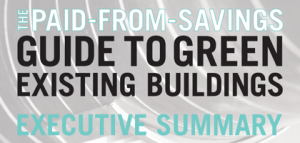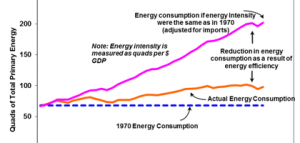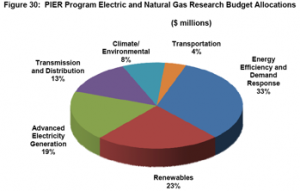
The best candidates for the paid-from-savings approach are buildings with inefficient or outdated building systems in which upgrades will generate significant cost savings. To achieve LEED for Existing Buildings: O&M certification, these systems must also meet energy-efficiency and performance-period requirements designated in the rating system. LEED for Existing Buildings: O&M certified buildings also implement O&M best practices and sustainable policies.
Executive Summary PDF
The paid-from-savings approach is a financing strategy to green existing buildings. It leverages the savings generated from building system upgrades to pay for a comprehensive greening project within a defined pay-back period. Paid-from-savings projects can use a variety of financing methods including:
• Self-financing,
• tax-exempt lease-purchase agreements for qualifying entities,
• power purchase agreements for renewable energy projects,
• performance contracts for larger projects,
• equipment finance agreements, and
•commercial loans or bond financing for qualifying entities.
In many cases, successful projects employ a combination of these options, along with supplemental funding, such as revolving loan funds, utility rebates, and renewable energy grants, as well as funds from the organization’s capital and operating budgets.
They include such items as:
• replacing the boiler,
• replacing the chiller,
• upgrading lighting systems,
• installing a building automation system (BAS), and
• replacing water fixtures.
Owners can achieve their desired return on investment (ROI) and lessen the overall project pay-back period by “bundling” the longer pay-back measures with the quicker pay-back measures to create a project with a shorter overall pay-back period and a higher ROI.
Under a performance contract, an energy services company (ESCO) acts as the project developer and assumes the technical and performance risk associated with the project, including guaranteeing the cost savings generated from the system upgrades for a specified period of time. If the savings guarantee is not met, the ESCO pays the owner the difference. The guarantee is unique to performance contracting and not typical of other paid-from-savings approaches.
To determine the savings that can be guaranteed, the ESCO will conduct an investment-grade energy audit, which provides the basis for calculating the guarantee and creating the project development plan. The audit also serves as the foundation for developing the measurement and verification (M&V) plan, which outlines the specific methods and calculations to ensure the expected savings are realized.
Share this post:







 Mayor Eric Garcetti – 4/8/2015: O
Mayor Eric Garcetti – 4/8/2015: O PACENow is pleased to release the Lender Support Study, which surveyed national, regional and local mortgage lenders whose interests in buildings could be affected by PACE financings. PACE programs in Washington, D.C., Los Angeles, and San Francisco retained PACENow to develop and implement the survey, with grant support provided by the Urban Sustainability Directors Network.
PACENow is pleased to release the Lender Support Study, which surveyed national, regional and local mortgage lenders whose interests in buildings could be affected by PACE financings. PACE programs in Washington, D.C., Los Angeles, and San Francisco retained PACENow to develop and implement the survey, with grant support provided by the Urban Sustainability Directors Network. U.S. energy use is approximately half of what it would have been if we had not improved our efficiency over the past 40 years. Still, there are large, cost-effective opportunities to increase energy efficiency much further, thereby helping us to cut energy bills, reduce pollution, and encourage economic growth.
U.S. energy use is approximately half of what it would have been if we had not improved our efficiency over the past 40 years. Still, there are large, cost-effective opportunities to increase energy efficiency much further, thereby helping us to cut energy bills, reduce pollution, and encourage economic growth. Energy service companies (ESCOs) have provided billions of dollars worth of energy savings through building retrofits — and inspired even the most reluctant clients to seek out energy efficiency. Yet certain building owners can achieve far greater energy and cost savings through the adoption of
Energy service companies (ESCOs) have provided billions of dollars worth of energy savings through building retrofits — and inspired even the most reluctant clients to seek out energy efficiency. Yet certain building owners can achieve far greater energy and cost savings through the adoption of 
 As part of Energy Upgrade California, owners of non-residential commercial properties in Los Angeles County have access to an innovative financing mechanism to fund up to 100% of the cost of building performance upgrades—Property Assessed Clean Energy (or PACE) financing.
As part of Energy Upgrade California, owners of non-residential commercial properties in Los Angeles County have access to an innovative financing mechanism to fund up to 100% of the cost of building performance upgrades—Property Assessed Clean Energy (or PACE) financing.  In this report, McKinsey offers a detailed analysis of the magnitude of the efficiency potential in non-transportation uses of energy, a thorough assessment of the barriers that impede the capture of greater efficiency, and an outline of the practical solutions available to unlock the potential.
In this report, McKinsey offers a detailed analysis of the magnitude of the efficiency potential in non-transportation uses of energy, a thorough assessment of the barriers that impede the capture of greater efficiency, and an outline of the practical solutions available to unlock the potential.
